Did you know that Liz is our resident linguistics expert? In the new #linguisticsliz series she’ll be demystifying some common grammar and punctuation rules that people (including copywriters!) often get wrong in their marketing copy. Today it’s all about the humble comma.
At my daughter’s assembly recently, the class dressed up as pop stars and sang a song called “AAAWWUBBIS”:
“Two clauses in one sentence yeah
You combine never asking why
A comma here
A comma there
It’s a mess no-one can deny”
Tears rolled down my cheeks at the sheer hilarious genius of it. The song is designed to help them remember when to use a comma in a complex sentence. The parent next to me whispered, “I thought you just chucked a comma in whenever you needed to pause for breath?” “No, no, no, there are RULES”, I replied in despair through my tears.
Get rid of that comma!
I am often called on to proofread copy for a website or blog before it is sent to clients. My mother was a professional proofreader and I have BSc in Language Technology so I feel at home finding typos and grammatical errors. My most frequent complaint to our writers [Rin’s note: Including me!] is the number of erroneous commas that appear before conjunctions which I must unceremoniously delete.
It is a common misconception that a comma can be thrown in whenever the reader might need to breathe. But actually there are specific points in English syntax where they are required and they cannot be thrown in on a whim.
Introducing clauses
Back to “AAAWWUBBIS”… AAAWWUBBIS is an acronym for the most common subordinating conjunctions in the English language…
“Stop, stop! What on earth is a subordinating conjunction and why do I need to know?”
You use them all the time to join up two clauses in a sentence.
“Wait. What? What’s a clause?”
OK, let’s rewind a few pages of the textbook: a clause is a mini sentence containing a verb.
For example:
I have written a blog post.
I will set off to pick my children up from school.
If I want to join these two ideas together and make one of them dependent (or subordinate) to the other I need a subordinating conjunction:
- After
- Although
- As
- When
- While
- Until
- Because
- Before
- If
- Since
See what those initials spell?
Complex sentences
Using a subordinating conjunction I can then write a complex sentence containing two clauses instead of one. There are two ways I could do this:
I will set off to pick up my children from school after I have written this blog post.
After I have written this blog post, I will set off to pick my children from school.
If I choose to use a subordinating conjunction at the start of the sentence then I need a comma between the clauses. If I use the subordinating conjunction in the middle of the sentence then I must not use a comma.
That is the rule – nothing to do with breathing or pausing!
P.S. There are lots of other sentence types that require a comma. For example, when using an adverbial phrase. I will save that for next time!
Every business needs written content. Website copy, blog posts, white papers, case studies – the list goes on. In a startup or micro business, this copy is often written by a founder or another member of the team. But eventually the need for either quality or quantity – or both – means it’s time to hire in a freelance copywriter or copywriting agency.
The question is, which one is right for your business?
In this article, we’re going to look at the advantages and disadvantages of freelance copywriters and copywriting agencies. This won’t help you select an individual writer or agency – you can read more about that in this post on how to hire a copywriter. Instead, we’ll go through some of the factors you should be considering in order to decide what will suit you best.
TL:DR
- Why use a freelance copywriter?
- Why use a copywriting agency?
- Is RH&Co right for your business?
- Conclusion
Why use a freelance copywriter?
A good freelance copywriter is worth their weight in gold. As well as our in-house writers and editors, we have a small but brilliant team of freelancers who are an integral part of the agency.
So we’re not here to suggest that copywriting agencies are in any way better than freelancers. In fact, there are many situations in which we would advise that you go down the freelance route.
Here are some factors that make freelancers appealing.
Cost
In most cases, a freelancer is likely to be less expensive than an agency simply because they don’t have the same overheads. They’re also unlikely to be earning over the VAT threshold, saving you a chunk of money if you yourself aren’t VAT registered.
Freelance rates vary widely depending on experience and even location (London prices tend to be higher than Bristol prices, for example). A junior might start out charging as little as £150 a day, whereas someone more specialist or experienced might charge four or more times that.
There is likely to be some crossover between the highest freelance rates and the rates charged by the smaller agencies though, so don’t be afraid to get a range of quotes. Just make sure you’re comparing like-for-like in terms of what’s being delivered.
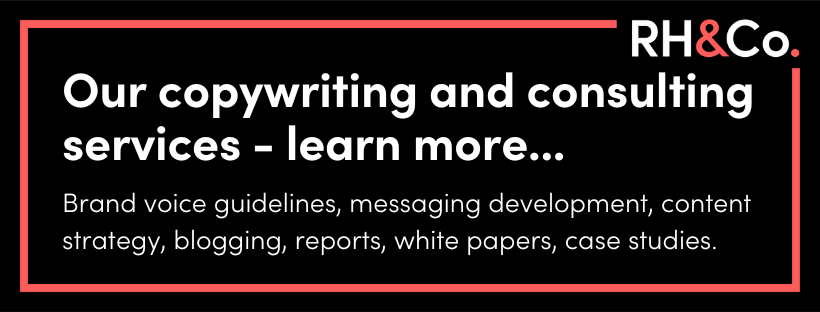
Flexibility
Where agencies will have their processes in place, a freelancer may well have more flexibility. For example, they might be happy to come and work in-house at your offices for a period of time. They are also unlikely to have minimum fee or retainer terms.
Retainer relationships do make sense on a number of levels. First, there is a degree of work to be done upfront in getting to know a client and understanding their industry, establishing tone of voice, messaging and more. Also, in the case of content marketing, it takes time to see results.
But you might not want a long-term relationship. Perhaps you only need someone to do a small, one-off piece of work, or perhaps your budget is too uncertain to commit to a monthly outgoing. Or you might just be testing the water. In which case, a freelancer may be a good bet.
Control
When you work with a freelance copywriter, they essentially become an extension of your team. You’ll manage them directly rather than going through an account manager, which may give you a greater sense of having eyes on all stages of the content creation process.
This is great for founders who are naturally close to their business and feel protective of anything that gets written on their behalf, or marketing managers who are used to managing a team, setting strategy, giving feedback and generally running projects.
If your business is growing and your copy requirements are likely to grow with it, then you need to be sure that your provision will be able to expand to meet that.
Why use a copywriting agency?
This is not where we do a big old sales pitch. As we’ve demonstrated above, there are many reasons why you might need a freelance copywriter. And if you find a good one, hold onto them!
But there will be times when getting an agency on board is going to suit your needs better.
A variety of experts
With a freelancer, you’re relying on one person to have a number of different skillsets. With an agency, you’ll get a team that brings together a variety of specialists.
For example, you might have a brand consultant to help you with your brand voice and messaging, a content strategist to help you create your editorial calendar, an account manager to interview your experts, a writer to create the draft content and an editor or proofreading to ensure it’s polished before it reaches you.
Consistent capacity
One key issue with freelancers is capacity. An agency will have greater internal resources, as well as access to a pool of tried and tested freelancers. What’s more, they’ll have processes in place for resource planning and managing consistency of quality. As a result, you shouldn’t have to wait weeks before they can fit you in and you’ll never have to worry about what happens if your writer gets sick or wants to take a holiday.
Likewise, if your business is growing and your copy requirements are likely to grow with it, then you need to be sure that your provision will be able to expand to meet that. One person can only do so much work, whereas a team has potentially infinite capacity.

Project management
As well as accessing a variety of strategic and creative experts, using a copywriting agency means you’ll have to do less on the project management side of things too.
An agency will provide a fully managed service, handling everything from brief creation through copy drafting, editing and proofing, managing the writers and even liaising with other professionals like designers or developers. That’s a lot less mental load for you to deal with.
Quality
We’re not suggesting that agencies produce better work than freelancers. But the reality is that there are plenty of bad copywriters out there. Choosing an agency should give you at least a minimum standard of quality.
A not-so-great freelancer might be able to get by on good luck but a substandard copywriting agency won’t last long. It’s just too competitive out there and running a business – with employees to pay, office space to rent, insurance, accountancy fees and a million other expenses besides – means there’s no room for slackers.
Is RH&Co right for your business?
Everything we’ve written so far has been designed to give you a broad brush and unbiased view of the copywriting market. Of course, not every freelance copywriter or copywriting agency is the same. So what about us?
Cost
Because no two projects are alike, we create proposals on a bespoke basis, taking into account factors like the type of work involved, the complexity of the subject matter, how quickly it needs to be turned around and the value it will deliver.
Our minimum project fee is £2,500+VAT, while retainers start at £1,250+VAT, with most of our regular clients tending to have annual budgets of between £15,000 and £50,000 for content.
We put our prices up every January as standard, to reflect the increased cost of living, our commitment to pay our team and freelancers fairly, and the increasing value we aim to deliver year on year. For the last two years this increase has been around 10%.
Specialism
Our specialism as an agency is in working with expert-led businesses to help them clarify and communicate their message and establish their expertise through content.
Our services include:
- A range of consultancy services around brand voice and messaging development, content strategy creation, and campaign design
- Creation of foundational copy for websites, pitch decks, corporate brochures etc
- Ongoing content creation including blogging, white papers, case studies etc.
Our writing team pulls together experience across a wide range of industries, primarily in tech, healthcare, sustainability and B2B services, and we are particularly experienced in working with complex subject matter to draw out the elements that readers will find engaging.
Flexibility
As a relatively small copywriting agency, we like to think of ourselves as being pretty agile in the way we work with our clients. However, we aren’t able to provide writers to work in-house on your premises.
We do work on both a project and a retainer basis, with retainer SLAs being set for a minimum of six months to ensure that we can provide the most value. In reality, most of our clients stay with us for much longer!
Team and capacity
With both in-house copywriting resources and a team of handpicked freelancers on our books, we almost always have capacity to work with new clients. We also have processes in place to cover sickness and holiday absence.
We can usually book in a kickoff session within a fortnight of you making the decision to work with us, during which we’ll agree on timeframes for your project. As a general rule, first time content projects tend to take a minimum of six weeks, although in some circustances we can work to tighter deadlines.
Every project, whether one-off or ongoing, has – at the very least – a dedicated project manager, a writer and a separate editor to ensure that the quality of the copy we produce meets RH&Co standards. You can find out more about the in-house team on our About page here.
Conclusion
Hopefully by now you’re feeling a lot more confident about whether or not you should be aiming to work with a freelance copywriter or a copywriting agency – and whether we might be a good fit. Let’s sum up the main points.
You should choose a freelance copywriter if:
- You have a small, one-off project such as a single flyer
- You have a limited budget for a bigger job such as a website
- You want the writer to work in-house in your offices
- You’re not ready to commit to a longer term relationship
You should choose a copywriting agency if:
- You want to ensure sufficient ongoing capacity
- You need the support of an experienced team
- You want be sure of a minimum standard of quality
- You’re committed to using copy strategically on an ongoing basis
Whether or not you should work with us is something you won’t fully be able to decide until you’ve had a chat with us. After all, you want to know that whoever you choose, you’re actually going to get on with them, right?
If you want to get to know us a bit better, drop us a line to arrange a call. In the meantime, feel free to have a look around the site, and why not connect with us on LinkedIn?
Have you ever had a project that involved some sort of writing, but had to ask yourself, “What kind of writer do I need?” Or have you thought you were asking the right person, only to find that’s not actually what they do?
Every now and then, someone will ask me if I can write them a press release or whether I’d be able to write the content for their social media feed. While technically the answer is yes, in reality I’m generally not the person they’re looking for. Key differences separate a copywriter from other types of writers.
If you have a writing project and you’re not sure who it is you need to hire in to do it, this guide will give you a nudge in the right direction.
TL:DR
- I need someone to write a press release
- I need someone to write posts for social media
- I need someone to check my writing
- I need someone to write my marketing plan
- I need someone to write my newsletter
I need someone to write a press release
A press release is literally that: information released to the press i.e. the media. It might be an announcement about a new product launch or an award nomination or a merger or an exciting new hire. Whatever the case, the idea is to get coverage in whatever media outlet you’re targeting. While a copywriter should be perfectly capable of writing a decent press release – especially if they have a journalistic background – the writing of the press release itself is only a small part of the PR process. Good PR professionals not only understand how the media works (and it’s a funny old world, very different from most business), they are also super star networkers and have the kind of industry connections that can get your story seen by the right people.
You need: a PR professional
I need someone to write posts for social media
Like in the PR example above, writing posts for Twitter, Facebook, LinkedIn and so on is just a small part of effectively using social media for your business. After all, it shouldn’t be about just pushing out content – much more important is engagement. That means it’s not simply a case of crafting a few snappy one liners and leaving it at that. A good social media manager will know not just what to write but how and when and to whom, and they’ll combine great copy with images, video and other media.
You need: a social media manager

I need someone to check my writing
If you’ve written a piece of content yourself – perhaps a white paper or an e-book – it’s a good idea to have a second pair of eyes glance over your work. And though it might be tempting to run it past a colleague, it’s definitely better if those eyes belong to a professional. But you don’t necessarily need a writer for this job. While a writer or even an editor could be useful you want help shaping and developing that piece of work, if what you’re actually looking for is someone to check spelling and grammar, key facts and overall sense and flow, then a proofreader is the best person for you.
You need: a proofreader
I need someone to write my marketing plan
Writing a marketing plan is less about great writing and much more about strategy. It’s an internal document, after all. Because your marketing plan should contain everything from your client personas to your pricing strategy, it’s not something someone can really do for you. However, if you don’t have a marketing manager or team you can work with internally, then a marketing strategist will be able to help you clarify the key points – after which they can certainly write up the marketing plan document itself if you wish.
You need: a marketing strategist
I need someone to write my newsletter
This could be something a copywriter would handle for you. It’s not all that different to website content. Certainly if all you’re looking for is the written text for your newsletter, then that’s fine – and we do look after newsletters for a few clients. But if you want the whole thing designed up too, it may be beyond the scope of a writer, depending on their skill set. And if you’re getting into full service email marketing – including strategy, delivery and analytics – then a specialist email marketing agency is almost certainly your best bet.
You need: an email marketing specialist
For most other things that you might need written for your business, you’ll find a copywriter should be able to help. Our core service offering covers website copy, blogging and video / animation scripts. But we also help our clients with everything from leaflets and brochures to email templates to LinkedIn profiles.
If you still aren’t sure who you need to help you with your project, let us know. If we can’t do it ourselves, we’ll almost certainly be able to refer you on to someone who can.
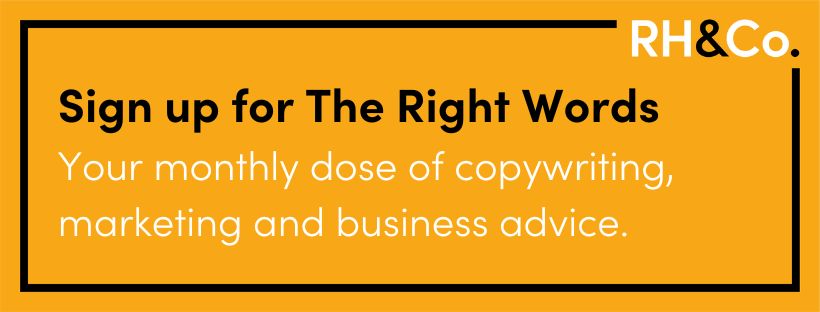
If you’ve ever been to a formal networking event, you’ll have had to do a 60 second pitch about your business. I’ve delivered hundreds of these so-called elevator pitches, usually off the cuff and often, if I’m honest, a little garbled. It’s not easy summarising who you are, what you do, who you work with and what you’re looking for in a mere minute.
That’s why at Entrepreneurial Spark they’re so insistent about practising your pitch over and over and over and over again. I’m sure I wasn’t the only person to feel like it was a bit much, having to start every meeting and mentoring session with a pitching session. But as I mentioned in my recent blog post about what I learned during my time on the programme, it turned out to be one of the most important things I did there.
So how exactly do you go about writing the pitch? Here’s how I constructed mine, following Entrepreneurial Spark’s format of Hook – Problem – Solution – Traction – Ask.
TL:DR
- Pitch step 01: HOOK
- Pitch step 02: PROBLEM
- Pitch step 03: SOLUTION
- Pitch step 04: TRACTION
- Pitch step 05: ASK
Pitch step 01: HOOK
“Just do it. Every little helps. Finger lickin’ good. When it comes to creating powerful marketing copy for your business, you don’t need many words, just the right ones.”
How you choose to open your pitch will determine if people keep listening or switch off. A clever question, interesting fact or statistic, or something else a little quirky that will make people take notice is what’s required here. Remember always to think about your target audience and what will resonate with them.
Pitch step 02: PROBLEM
“There are over 200,000 words in the English language and the average native speaker has an active vocabulary of around 20,000. So how do you find the right words to describe what your business offers and make your brand stand out from the crowd?”
Here again it’s important to put yourself in the shoes of your ideal client or customer and understand what the problem is from their point of view. I might be able to see that someone’s website content has syntax issues or lacks clear calls to action, but for them the problem is more likely to be, “How do I make people notice my business?” So that’s the problem I need to be talking about in my pitch.
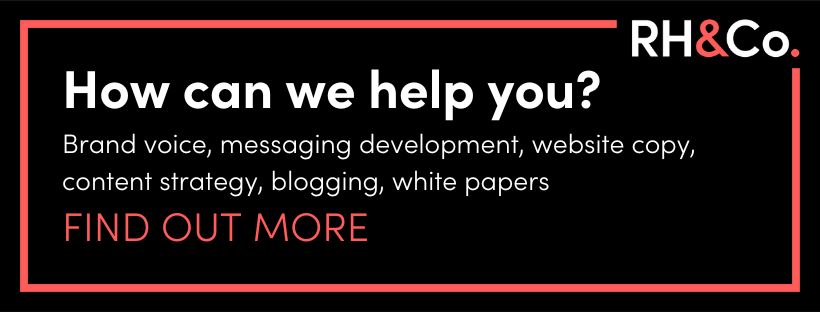
Pitch step 03: SOLUTION
“I’m Rin Hamburgh and I love words. I’ve been a professional writer for 14 years and set up Rin Hamburgh & Co last year when I saw the need for reliable, top quality yet cost effective copywriting services. By bringing in my team of freelance writers on a project by project basis, I can keep costs reasonable while also meeting the tightest of deadlines.”
This is where you get to talk about your business and how what you do can genuinely add value for your target audience. My solution starts off by explaining who I am and what I do, and then goes on to give a bit of detail about how I do it. This kind of insight is really valuable when it comes to differentiating your business from your competitors.
Pitch step 04: TRACTION
“We work with anyone who can’t write, doesn’t enjoy writing or simply doesn’t have the time, and since our launch in August last year we’ve helped over 80 clients ranging from small businesses to household name brands improve their marketing copy.”
The next step is traction. This is a particularly important step for a start up – especially if you’re looking for funding – and is your chance to show that you’re already up and running and having some success. But it’s also a valuable section for more established businesses. Telling people that you’ve been going for 20 years or have worked with a number of well known brands gives you credibility and helps build trust.
Pitch step 05: ASK
“Now we’re ready to increase our capacity, so I’m looking for introductions to keen junior copywriters who can join our growing team. And of course, if you know anyone who is struggling to find the right words to make their brand stand out from the crowd, we’re always here to help.”
Finally, it’s really important that your pitch has a clear ask, especially in a formal networking situation. My pitch was aimed at fellow ESpark entrepreneurs, so it was less about sales and more about support – hence the request for leads for new copywriters. But you might be looking for an introduction into a particular business, referrals from within a certain industry or people to sign up to your newsletter or join a focus group to help you test a new product. The more specific you can be, the easier people will find it to help you.
Once you’ve written your pitch, go through it and try to cut out any unnecessary words or even whole sentences. You’ll need the overall word count to be less than 180 words, which is roughly how many you can fit into a minute without rushing.
Then all that’s left is to practice and practice and practice some more, until the words roll off your tongue and you feel comfortable delivering your pitch in any situation, even at short notice – like if you should happen to get stuck in a lift with your ideal client.

“What should I look for in a copywriter?” I was so pleased to be asked this question recently. It’s one I wish more people asked. After all, if you’re going to entrust the words that represent your brand to someone, you want to make sure they’re going to do a good job. But so few people do any real research before making their choice.
What is a copywriter?
First things first, let’s define what a copywriter actually is and does. And no, it’s nothing to do with helping businesses secure copyright for their products or ideas.
The Merriam-Webster dictionary defines a copywriter as “someone whose job is to write the words for advertisements”. But that definition is pretty old fashioned and limited.
In fact, a good copywriter should be able to produce everything from website copy to blog posts, ad text, brochures, white papers, social media content, flyers, video scripts and more. Basically, if you need words for your business, go to a copywriter.
More than good grammar
So how do you tell whether someone is a good copywriter or not? Because it’s not as simple as being able to “write nicely”, or making sure the spelling, grammar and punctuation is right.
Those things are important, of course, but let’s face it – there are quite a few people who passed their GCSE English exams. Unlike brain surgery or advanced robotics, we all learn to write to some degree at school, which means plenty of people are more than capable of stringing a passable sentence together.
So, here’s what a copywriter needs to do for you…

A good copywriter will draw out your message
The copywriting process begins during the briefing, when your copywriter should be able to go beyond what you’re telling them and ask the kind of questions that really get to the heart of what you’re trying to communicate.
A good copywriter will sell the benefits
Whether writing a simple flyer or a complex website, it’s about understanding your target audience and what benefits will help them make the decision to buy from you. Yes, you might sell the most sophisticated widgets in town, but if your customers care about the fact that those widgets will protect their kids or save them money on their water bill then that’s what you need to talk about first, not the flashy tech.
A good copywriter will guide people around your website
Focusing just on website content now, one really important issue is navigability. Having gained a visitor to your site, the last thing you want is for them to click away before they’ve found what they’re looking for. Having understood your target clients, a good copywriter will use each element of the text – especially on the home page and any other landing pages – to clearly and quickly funnel them to the most relevant part of the site for their needs.
A good copywriter will understand page furniture
Strictly speaking a magazine term, but one that can apply more generally across any published material, on or offline. From subheads and bullet points that break up copy and improve scannability, to eye-catching pull quotes and buttons that drive action, there’s a lot more to great copy than well written body text.
A good copywriter will use the right amount of words
Which is usually less than you’d think. A good copywriter isn’t enamoured with the eloquence of their own writing. They understand that the reader is busy and probably just needs to get to the point. Of course, there are exceptions – but a good copywriter will know that too!
If you’re planning on getting a professional in to help you with your marketing copy, do make sure you do a bit of digging to see whether they’ll be able to genuinely help you. Check out their qualifications, ask for referrals and most importantly, have a look at work they’ve already done.
Because if you pick someone who simply “writes nicely” and spells properly, you’re going to miss out. And I don’t want that for you, because your business is worth more than that and if you’re going to pay a professional, you need to know that they’re really good at what they do.

Making the decision to spend money takes some thought, and the more money involved, the more thought it needs. Assuming you’re not selling penny sweets, your clients and customers are likely to go through a journey something like this when it comes to their relationship with your brand:
Know – Like – Trust – Try – Buy – Repeat – Refer
This is a helpful way to think about your marketing, which should be meeting customers wherever they are along that path. And each stage will have a particular style of marketing that suits it. Although you’ll need to experiment to see what works best for your brand, here are a few ideas to get you started…
Know
Brand awareness is an important marketing goal but it can be hard to track ROI (return on investment). The key is to target fairly widely while keeping costs low. For that reason, social media is a good option at this stage. Make sure that you’re very clear about differentiating yourself from the competition, and be sure to clearly communicate your core brand values, benefits and so on from the outset.
Like
If you’ve done your client personas, you’ll know exactly what your target audience wants and needs, which means it shouldn’t be too hard to get them to like your brand. You can use pretty much any kind of media to engage your audience at this stage – blog posts, video, social – so long as it adds value for them. Creating personalised and segmented content will help get them to the like stage much more quickly.

Trust
People are far more likely to buy from you if someone they know or respect endorses you. Testimonials, case studies and referrals on platforms like LinkedIn can go a long way to building trust, so don’t neglect this aspect of your marketing. Establishing expertise is another important way to build trust, and this can be done very effectively via a blog or vlog, or by being quoted as an expert in relevant press.
Try
Promotional offers are a great way to get people to try your products and services, reducing the amount of thought they need to put into the transaction by reducing the price. But some brands prefer to avoid discounting as a strategy. In that case, you could offer a taster product or service. For example, free webinars or low cost workshops are a popular way for service businesses to get people trying what they have to offer. The equivalent in retail might be sample size perfumes.
Buy
This is the stage where you leave the realm of marketing, and step sideways into sales. But don’t ditch your marketing hat completely. If you’ve got a potential buyer who is wavering, you’ll need to support their transition to the sale by reinforcing all the messaging you’ve used in the stages leading to this moment, especially the ones around trust. That’s why testimonials on a sales pages are an absolute must.
Repeat
If you think that once people have reached the buy stage you can forget about marketing, I’m afraid you’re wrong! If you’ve spent all this time getting a client on board, it would be frustrating for them to disappear after one transaction. Capturing email data at this stage is vital so you can use it to follow up and ensure that the aftercare they get reinforces their great customer experience so far.
Refer
Getting referrals from happy clients is the holy grail of marketing, but most businesses forget to ask for them. There’s nothing wrong with a follow up email a week or two after a sale has been made or a job completed, checking on how everything is going, whether your customer would be happy to write a testimonial or refer you to someone they know who might be looking for something similar. You could even incentivise referrals, for example offering discounts to both parties for any work that comes from it.
Thinking through your customer’s buying journey like this will help you create the right message for the right stage, and should get more people to ‘buy’ and beyond. As always, experiment and don’t hesitate to ask for feedback when people reach the buy stage to find out what helped them along the way.

For punctuation pedants, a misplaced apostrophe is the cause of much rage. Their blood boils at the sight of this elevated comma being used in the wrong place.
At RH&Co we try to stay mellow about it – after all, none of us can put together a change management plan or code even a single line of Javascript. Everyone has different skills, right?
But when it comes to business writing, it is important to get the basics right. While the odd typo is inevitable, consistently poor spelling, punctuation and grammar will mark you out as unprofessional.
Which is why we thought you’d appreciate this little guide on how to use an apostrophe correctly…
To replace missing letters
This is the most basic rule for apostrophes, so people usually get it right. When do not becomes don’t, the apostrophe takes the place of the second o. When they will becomes they’ll, it is there in the place of both the w and the i. This is what you call a common contraction. So far, so simple.
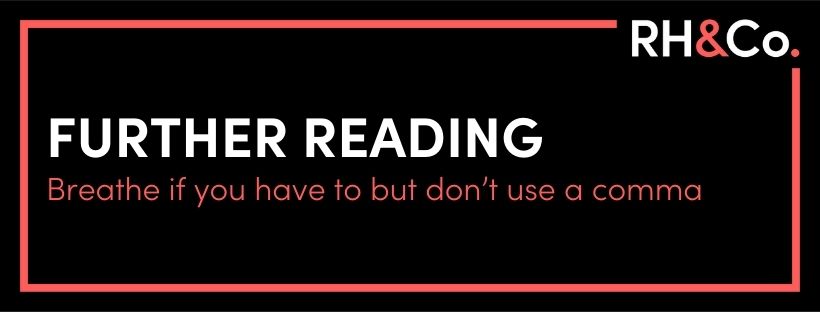
To signify possession
This bit also starts off in a relatively uncomplicated fashion. When Susan buys a book, it is Susan’s book. When the builder makes a sandwich, it is the builder’s sandwich. This is the possessive apostrophe at work.
What if the builder is really hungry and has two sandwiches? Same deal as with the singular form – the builder’s sandwiches. But what if there are several builders? Now we need to move the apostrophe so that it comes after the pluralising s: the (many) builders’ sandwiches.
The same goes for the Smith family. While Fido might be Mrs Smith’s dog (apostrophe before the s), he is also the Smiths’ dog – the dog belonging to the Smiths as a group – or the Smiths’s dog.
It’s worth noting that if the family’s surname ends with an s, you’ll need to pluralise it before adding the apostrophe. So while Mittens is Mr Williams’ cat, she is also the Williamses’ cat.
Just watch out for irregular nouns, which become plural in a way other than by adding an s or es – like child, which becomes children (rather than childs). If you want to refer to toys belonging to said children, you would say the children’s toys and not the childrens’ toys (because the plural of child is not childrens).
Still with us?

Its vs It’s
There is an exception to the possessive apostrophe: it. Since a sandwich belonging to a builder is the builder’s sandwich, it should follow that a sandwich belonging to it (say, a dog of non-specific gender) is it’s sandwich. This is an understandable and common mistake.
Instead, the dog would eat its sandwich. The bird would build its nest. A company would look after its staff and a plant would absorb water through its roots.
The only reason to add an apostrophe to its is if you’re using it as the contraction of it is ie it’s. In this case, the apostrophe signifies the missing i, as per rule number one above.If in doubt, try lengthening its to it is – if it doesn’t work, you don’t need an apostrophe. As an example, you wouldn’t say that the floppy disc has had it is day, therefore you should write the floppy disc has had its day, and not it’s day.
Acronyms
For some people, all of this is still relatively straight forward. Until they meet an acronym. Then for some reason they decide it’s time to throw the rulebook out of the window, and use an apostrophe before an s that is being used to create a plural, rather than to show possession.
So while they’d never say that one file becomes two file’s, they’ll happily talk about the garage that offers excellent MOT’s, the shortage of ATM’s in town, and how difficult it is to remember so many PIN’s. (Incidentally, this actually does make us feel quite twitchy.)Remember, unless you are signifying possession (the ATM’s screen or, if dealing with many ATMs, the ATMs’ screens) you don’t need that apostrophe.
Exceptions
We’re fairly certain that the English language was designed to confuse, which means you will always find an exception to any rule – including those relating to punctuation marks.
For example, if you wanted to say that when people’s handwriting is bad, their as often look like us, it’s probably helpful to add apostrophes to make your meaning clear: when people’s handwriting is bad, their a’s often look like u’s.
Likewise, you might want to write about the do’s and don’ts of using apostrophes (even though it’s actually incorrect) because it’s just clearer than dos and don’ts (which is the correct form). We like to call this a creative apostrophe.So there we have it. Not all that hard, is it? Feel free to copy and paste this post into your brand style guide! And if you’re still struggling with apostrophe confusion, email us and one of our punctuation nerds will set you straight.
There are many benefits of blogging for business. Well written blog posts can add real value for your audience while showing off the expertise in your business and driving traffic to your website – to name just a few.
But if you’re just starting out with creating a blogging strategy, it can be hard to know, well, where to start. There are just so many things to think about. Here are a few questions people ask us all the time and the answers we usually give them.
TL:DR
- How long should my blog posts be?
- How often should I blog?
- How often should I mention my keyword phrase?
- Do I need to use lots of images in my blog?
How long should my blog posts be?
Yes, it’s frustrating when people respond with, “How long’s a piece of string?” But the truth is that the length of your blog post will depend on a number of factors. For example, what is the subject of your post? Are you tackling a complex issue or showing off images of your latest products? Likewise, who is your audience – a busy parent trying to find a way to entertain the kids on a rainy weekend, or a CHRO looking at employee retention trends?
There are some general rules though. For example, a blog post should be a minimum of 300 words to satisfy search engines that you’ve actually got enough valuable content in there to make it worth directing people to the page. That said, many social posts these days are heading towards that number of words, so consider where the best place is to share those shorter pieces of content.
Google’s priority is serving people the most valuable content for any given search enquiry. That’s why they released the Helpful Content algorithm update. So yes, we can talk about keywords but let’s not be blinkered by them.
On the other end of the scale, there’s evidence that long form content – up to several thousand words – can be really effective for generating backlinks and social shares, for example. The trouble with these longer posts is that they’re harder to write. Keeping someone engaged for that length of time takes skill and practice.
So what’s the answer? We usually recommend aiming for 800-1,200 words as a good average. But really, write as much as the blog needs, no more, no less.
Top tip: Use your site’s analytic tools and experiment with different post lengths to see which ones get the best engagement. Remember, you need to set goals for your blog so you know exactly what to track!
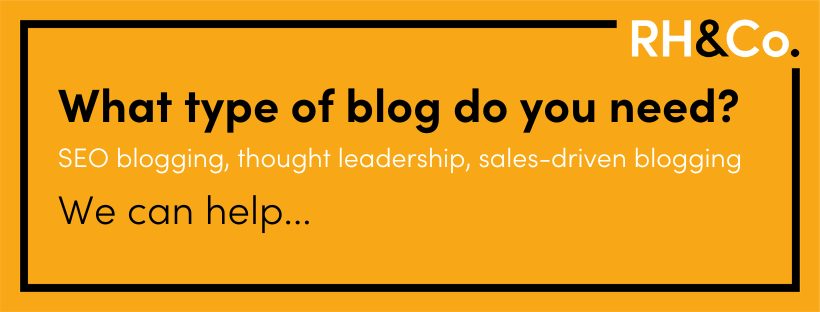
How often should I blog?
Again, the answer isn’t as straightforward as a single number. In part, it depends on your reason for blogging. If you’re doing a big SEO push then you’ll want to create as much well written and well optimised content as you can – Hubspot suggests as many as 3-4 smaller posts and 4-5 larger ones each week!
Of course, not every business has the time or budget to put that many posts out. And that’s ok. Your strategy might be centred around establishing your brand authority with high quality thought leadership, in which case 2-4 posts per month may well be enough.
What we do say is that posting a blog less than twice a month is pretty much pointless. The impact of such infrequent content creation will be so minimal that you’re likely to give up well before you see positive results. Fortnightly is good, weekly is great and if you have the resources to do more, then brilliant, you’ll most likely see results that much more quickly.
Top tip: If you know you won’t be able to blog consistently, why not create a ‘resources’ page of evergreen* content with no date attached to each article. That way you can add to it when you’re able to but it never feels out of date. (*This just means it’s always relevant rather than linked to a particular current event).
How often should I mention my keyword phrase?
Before we get into this, let’s be clear about one thing: Google’s priority is serving people the most valuable content for any given search enquiry. That’s why they released the Helpful Content algorithm update. So yes, we can talk about keywords but let’s not be blinkered by them.
If you’re writing your blog in order to drive organic search traffic, you’ll need to be sure that you’ve got a solid SEO strategy in place. Even the most brilliantly optimised content is going to struggle if your page load times aren’t fast enough or you haven’t got the right security tags.
It’s important to understand which keywords you’ve got a chance of ranking for too. You want to find that sweet spot between high search volume and low competition. You also need to have an idea of search intent so you know you’re capturing the right audience with your content.
But let’s assume you have a particular keyword or phrase you feel confident you could rank for. While there’s no magic number you need to hit in order to rank, it does help to prioritise using your keyword or phrase in titles (H1 and H2) as well as the first paragraph or two of the blog post.
As for the rest of the post, remember that you need to write for your audience first. Stuffing a post full of keywords will make it sound false and Google doesn’t like it either. It’s worth noting that search engines consider synonyms and synonym phrases when looking at how genuine and helpful a post is. So if you’re writing about nutrition, you can – and should – also be writing about healthy eating, diet, nourishment and so on.
Top tip: Internal links will give your search a boost by increasing your reader’s time on your site and number of pages visited, signalling to Google that your content is valuable and answers their questions.

Do I need to use lots of images in my blog?
You don’t have to but they help. Images break up a page in the same way as formatting tools such as subheads, bullet points and pull quotes. They make the text more accessible and easy to read, which will reduce the amount of people who give up after a paragraph or two.
For some businesses this is easy. If you’re selling jewellery or luxury holidays or interior design services, there are plenty of options to choose from. But what about those businesses whose offering is less tangible or less visually appealing?
Well, take a look through this blog post. We’ve created ‘further reading’ panels using our brand colours and fonts to make the page more interesting while also adding value for you, our reader. In other posts we’ve used screen shots to illustrate points we’re making about website copy, for example. Or you might find graphs and charts helpful.
Remember that images should always be high quality, and you’ll need to ensure you’re not breaking any copyright laws by stealing them from elsewhere on the internet. If you don’t have your own, you can buy stock images from sites like Shutterstock and iStock, or get them free from the likes of Unsplash and Pexels.
Top tip: Make sure your images are contributing to your SEO efforts by adding keywords to the image file name, title, alt and description text. The latter is also essential for those using screen readers, improving your post’s accessibility and giving you another point on Google’s score sheet.
